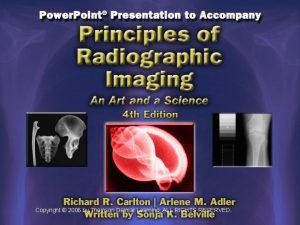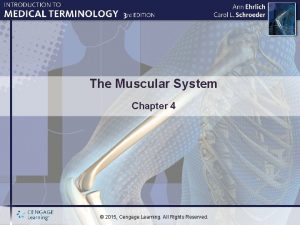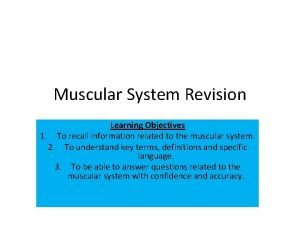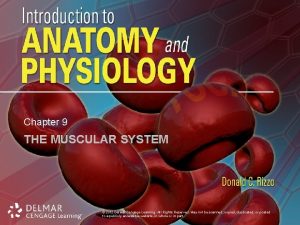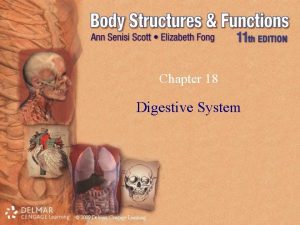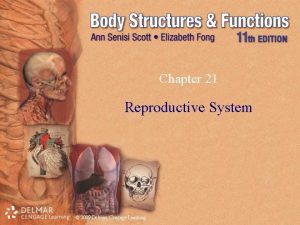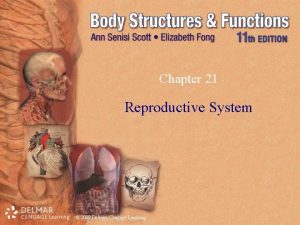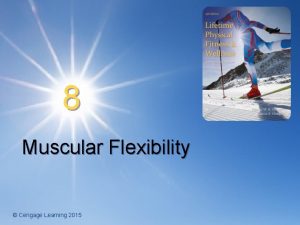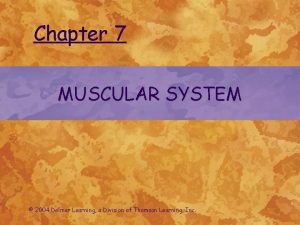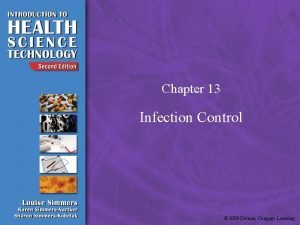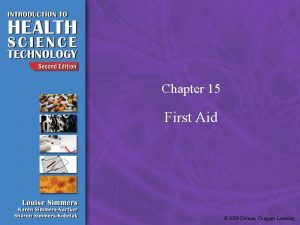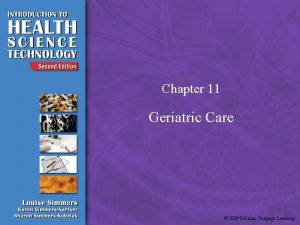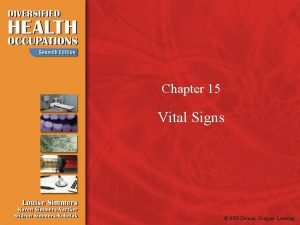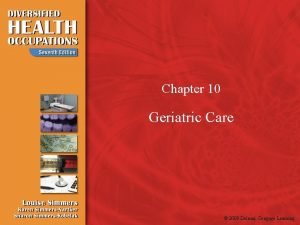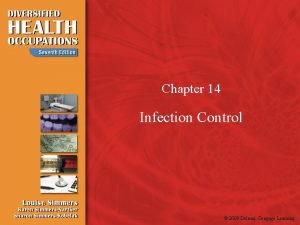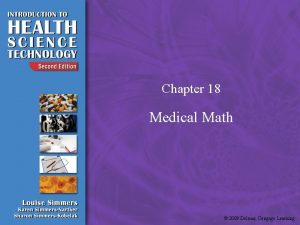Chapter 7 Muscular System 2009 Delmar Cengage Learning





















- Slides: 21

Chapter 7 Muscular System © 2009 Delmar, Cengage Learning

Functions of Muscular System • Body heat to maintain body temperature • Body movement • Body form and shape to maintain posture © 2009 Delmar, Cengage Learning

Types of Muscles • Skeletal muscle • Smooth muscle • Cardiac muscle © 2009 Delmar, Cengage Learning

Skeletal Muscle • Under conscious control • Attached to the bones of the skeleton • Each muscle cell is known as a muscle fiber © 2009 Delmar, Cengage Learning

Smooth Muscle • Not under conscious control • Found in the walls of internal organs • Controlled by the autonomic nervous system © 2009 Delmar, Cengage Learning

Cardiac Muscle • In the heart only • Not under conscious control • Requires a continuous supply of oxygen to function © 2009 Delmar, Cengage Learning

Special Circular Muscles • Sphincter or dilator muscles – Located in the openings between the esophagus and stomach, and the stomach and small intestine – Function is to control the passage of substances by opening and closing © 2009 Delmar, Cengage Learning

Summary of Muscle Tissue Feature Skeletal Smooth (Visceral) Cardiac Location Attached to bones Walls of internal organs Heart and blood vessels Function Produce body movement Contraction of visceral and blood vessels Cell Shape Cylindric Spindle shaped, tapered Cylindric, branching ends Number of Nuclei Many One Striations Present Absent Present Involuntary Type of Control Voluntary © 2009 Delmar, Cengage Learning Pump blood through heart and blood vessels

Characteristics of Muscles • • Contractibility Excitability or irritability Extensibility Elasticity © 2009 Delmar, Cengage Learning

Muscle Attachments and Functions • Over 650 muscles in the body • Muscles must be attached to bones for leverage • Muscles only pull, never push • Attached to bone by tendons © 2009 Delmar, Cengage Learning • Muscles are attached at both ends • Attachments may be to bones, cartilage, ligaments, tendons, skin or to each other • Origin and insertion • Prime mover and antagonist • Synergists

Sources of Energy and Heat • Narrow range of normal body temperature – 98. 6 °F to 99. 8°F • ATP (adenosine triphosphate) – Need oxygen, glucose, and other material to make – By-product is lactic acid © 2009 Delmar, Cengage Learning

Contraction of Skeletal Muscle • Myoneural stimulation • Contraction of muscle proteins © 2009 Delmar, Cengage Learning

© 2009 Delmar, Cengage Learning

Principle Skeletal Muscles • Skeletal or voluntary muscles – Move the skeleton • Also control movement of the eyeballs, eyelids, lips, tongues, and skin © 2009 Delmar, Cengage Learning

Naming of Skeletal Muscles • • • Location Size Direction Number of origins Location of origin and insertion Not all muscles are named by above method © 2009 Delmar, Cengage Learning

Muscles • 656 muscles • 327 antagonistic muscle pairs and two unpaired muscles – Orbicularis oris – Diaphragm • Muscle regions – Head muscles – Neck muscles – Trunk and extremity muscles © 2009 Delmar, Cengage Learning

Muscles of the Head and Neck • Control expressions • Mastication • Movement of the head © 2009 Delmar, Cengage Learning

© 2009 Delmar, Cengage Learning

Muscles of the Upper Extremities • Shoulder, arm and hand movements © 2009 Delmar, Cengage Learning

Muscles of the Trunk • Breathing and movement of the abdomen and pelvis © 2009 Delmar, Cengage Learning

Muscles of the Lower Extremities • Thigh, leg, ankle, foot, and toes © 2009 Delmar, Cengage Learning
 2009 delmar cengage learning
2009 delmar cengage learning 2009 delmar cengage learning
2009 delmar cengage learning Challenge word building medical terminology
Challenge word building medical terminology 2009 delmar cengage learning
2009 delmar cengage learning Chapter 6 skeletal system
Chapter 6 skeletal system 2009 delmar cengage learning
2009 delmar cengage learning 2009 delmar cengage learning
2009 delmar cengage learning Delmar cengage learning instructor resources
Delmar cengage learning instructor resources Thomson delmar learning
Thomson delmar learning Dorsiflexion word parts
Dorsiflexion word parts Chapter 7 cengage
Chapter 7 cengage Plyometrics disadvantages
Plyometrics disadvantages Muscular system learning objectives
Muscular system learning objectives Chapter 5 the cardiovascular system
Chapter 5 the cardiovascular system Cengage learning heart diagram
Cengage learning heart diagram South-western cengage learning
South-western cengage learning Cengage learning heart diagram
Cengage learning heart diagram Cengage learning australia
Cengage learning australia Cengage learning
Cengage learning Cengage learning
Cengage learning Wadsworth cengage learning
Wadsworth cengage learning Cengage learning
Cengage learning








